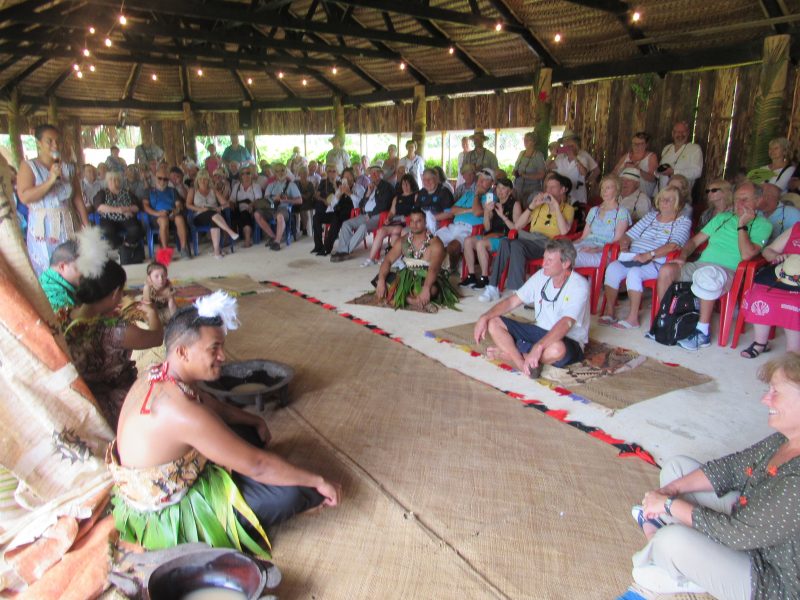
By HENRY BENDER
Hey Gang,
Queen Victoria’s banging today — a lot! Waves are pushing six meters — that’s 21 feet. Some are probably higher. And the wind, well, she’s screaming like a banshee. Swimming pools are closed, so are the hot tubs, and several doors leading to the outside decks have been cordoned off. When I bumped into Captain Connery — he was coming from the bridge — I asked if he was concerned.
“Not at all,” he laughed. “We’re only experiencing some zephyrs with a little roughness.”
Some zephyrs? A little roughness? Barf bags are by every elevator! The Brits. You got to love them. They’re masters of understatement.
Right now, we’re barreling toward Australia. Another two days, we’ll be in Sydney. As I write this, we’re about 33 degrees south latitude/170 degrees east longitude, which places us — yep, you got it — Down Under in the southeast hemisphere, an area of the world where Karen and I have never been.
Only a few days ago, we were sailing around New Zealand — home to volcanoes, Kiwi fruit, and Maori culture. Oh, I almost forgot. And, the America’s Cup! That’s right. The Kiwis won the Auld Mug two years ago. So now, we Yanks will have to come to Auckland — New Zealand’s largest city — in 2021 to have a go at winning it back.

Author Henry Bender cranks up the main sail on the America's Cup Yacht, the NZL68
Located in the northern region of New Zealand’s North Island, Auckland spreads for 30 miles over an isthmus that connects two major harbors: Waitemata and Manukau. Maori call this land Tamaki Makaurau — a maiden desired by a hundred lovers. Green, lush and seductive, the volcanic hills surrounding the city are simply gorgeous.
Cup races are slated for the waters beyond Waitemata, where the island of Rangitoto, one of the most symmetrical volcanoes in the world (last eruption was 600 years ago) stands sentinel by the harbor’s entrance.
For fun, Karen and I signed onboard a genuine America’s Cup yacht, the NZL68, for a spin out there. The yacht was used by the Kiwis in Cup trials back in 2007. Long and narrow like a Maori war canoe, this skinny fiberglass shell, 78 feet in length, with a mast that shoots up 113 feet, was built with one intention only — to fly. And fly we did. We flew across Waitemata Harbor, we flew past the harbor bridge, and we flew past Rangitoto; in fact, we flew past every boat out there. And believe me, there were plenty. Auckland’s sobriquet is City of Sails. One in three households owns a boat!
I’ll tell you, it was a workout spinning those “grinders.” They’re the big winches that crank in the sails. My shoulders were aching. Best part though was manning the helm. For about ten minutes, yours truly pretended he was Dennis Connor. Ha!
Back at Viaduct Basin where we boarded the yacht — this man-made harbor is lined with some of the coolest cafes, restaurants, and bars you’d ever see — I said to Karen, “Let’s have a drink to celebrate our America’s Cup sail.”
At first, she hesitated, but after I whispered, “New Zealand’s known for its Sauvignon Blanc” there wasn’t much arm twisting. Sauvignon Blanc is one of her favorite wines. When Happy Hour rolled around four hours later, we were hanging with locals in The Crab Shack — our third watering-hole — over on Princess Wharf chowing down on
greasies. That’s what the Kiwis call fish ‘n chips. Of course, my shoulders weren’t feeling any pain!
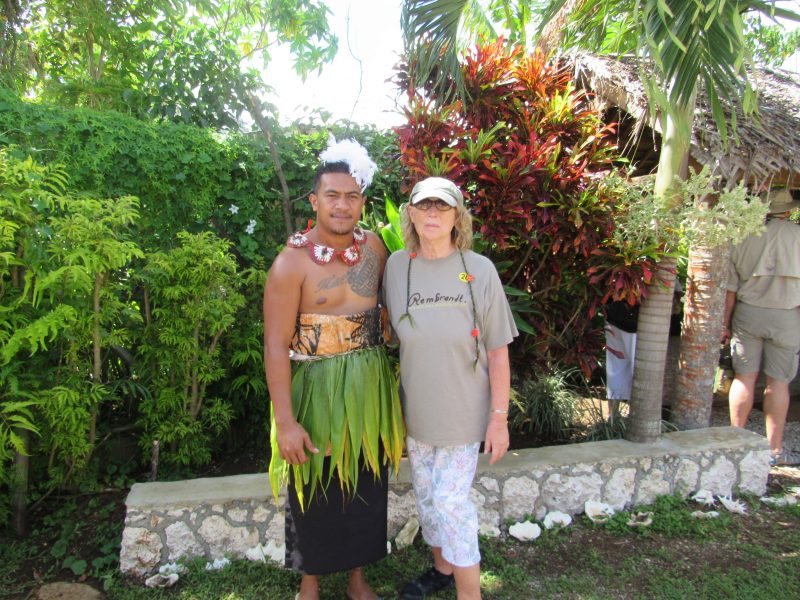
The author's wife, Karen Bender, is joined by a Tongan warrior.
Anyhow, as I mentioned previously, Maori culture thrives in New Zealand or Aotearoa — that’s the Maori name for these islands. The earliest tribes arrived in the late 12
th century. What boggles my mind is how they made their way from Polynesia. Imagine, sliding down 20-foot waves in open sailing canoes. They must’ve been crazy!
Before Auckland, Queen Victoria called on Tauranga, about 125 miles to the south. Meaning sheltered anchorage, Tauranga is the largest city in the Bay of Plenty (Captain Cook’s appellation; given when he arrived in 1769) where kiwi fruit and avocadoes are the major exports.
A tour we went on stopped at a Maori school. For about an hour some Maori teeny-boppers dressed in ancient garb showcased their ancestors’ ways along with some older teens. Girls sang, they danced, they waved their arms as bare-chested boys, stuck out their tongues, bulged their eyes, and waved wooden spears.
Other than this focus on culture and heritage, the school’s curriculum is really no different than that of an American or European school. English, math, science — it’s all being taught. We sat inside a gymnasium on fold-out chairs for the entertainment. Outside, newly paved tennis courts baked in the sun.
Afterwards we were whisked off to a
marae, a Maori tribe gathering place — a building that resembles a church with tiki decorations — for a rather formal Maori ceremony.

A woman and a local warrior greet visitors at a "marae," a Maori gathering place.
When we climbed from our bus, we all assembled at the marae’s gateway. Women were instructed to stand in the front. A local warrior then greeted us. His job was to make sure we weren’t going to kill anyone. Once peaceful intentions were realized, a Maori woman from the marae started chanting, calling out to our ancestors to join hers.
After her chant, our women and men switched positions — men now up front; women in the rear. Then everyone removed their shoes, and we entered the marae where we sat on long wooden benches. Since men led the way in, we sat upfront facing the tribe’s chief and other VIPs.
Once seated, two speeches followed, welcoming us — one in Maori, the other in English. Then we sang a
waiata or song. When it finally came time to leave, we queued up and touched noses and foreheads with tribe members. Called a
hongi, this is the most sacred part of the ceremony, because the gesture represents sharing life, peace, and knowledge.
Just in case you’re wondering, no one was sporting grass skirts or running around in their birthday suit. The Maoris dress like typical Europeans or Americans. But hey, they are inked up, and their tattoos tell stories — stories personal to them.
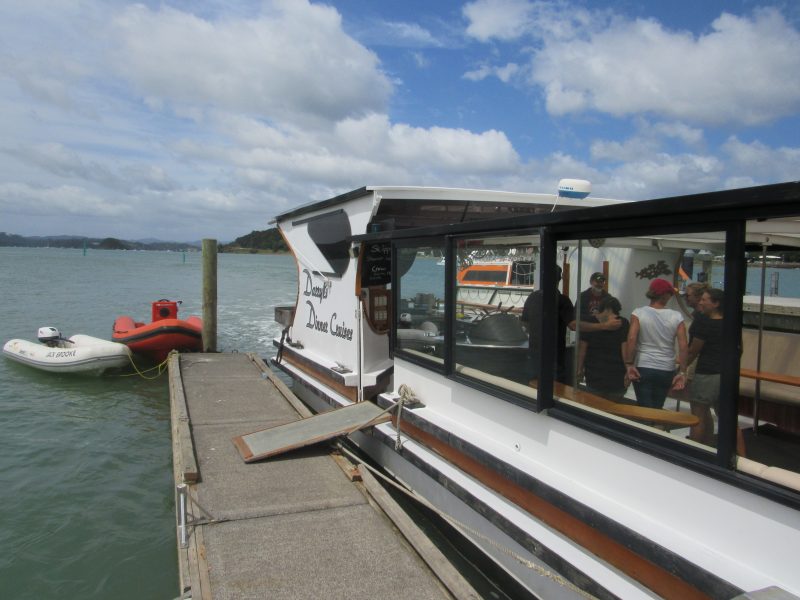
The picturesque Bay of Islands is another port-of-call on the tour.
The Bay of Islands (another Captain Cook appellation) 150 miles north of Auckland was our final port-of-call. Rolling landscapes. Silvery beaches. Rich forest land. This archipelago, dubbed New Zealand’s finest maritime park, consists of 144 islands.
Here, Queen Victoria dropped anchor in the main bay, only a stone’s throw from the small town of Waitangi. Waitangi means weeping waters. A slow-moving river of the same name runs past the town. Once our anchor was set, several lifeboats were lowered as tenders, and passengers were shuttled to Waitangi’s small wharf.
There, Karen and I joined thirty others aboard a flat bottom river boat for a leisurely cruise to Russell, one of New Zealand’s oldest towns. The journey only took about thirty minutes. Quiet and sleepy, you’d never suspect this little waterfront village with its quaint old homesteads, historic churches, and wooden cottages was once over-run with drunk sailors and prositutes. But it was. Founded as a whaling port early in the 19
th century, Russell was known as the “hell-hole” of the southwest Pacific. It was also New Zealand’s capital from 1840 to 1844.
In 1866 angry Maoris tried burning this little den of iniquity to the ground. Why? Because they were upset about the Waitangi Treaty. As the story goes, Maori chiefs in 1840 mistakenly signed away their sovereignty, handing it all over to Great Britain. When they realized they’d screwed up, it was too late, the ink on the parchment was already dry. As you’d might expect the Maoris claimed they’d been duped. Whether they were, no one’s certain. But the treaty’s still in effect, and still stirs up protests from time to time.
Fortunately, though, for the sailors and harlots, Russell’s prized bordello — New Zealand’s first house of ill-repute — survived the inferno. Today, refurbished and remodeled, this tiny white bungalow, which sits on the outskirts of town, operates as an expensive rental property. Yep, this tiny tribute to Russell’s bawdy past, now rakes in bucks weekly rather than hourly. We passed it after leaving Russell on our way to the oyster farms.

Russell, one of New Zealand's oldest towns, features an old former bordello that now functions as a rental property.
The Kororareka Oyster farms aren’t much of a tourist attraction There’s nothing to see but water. So, we moseyed around enjoying views of the picturesque countryside. Around noon, the captain dropped the hook and his crew served up lunch. Venison. Lamb. Gurnard, which is a local fish. Boiled white potatoes. Tossed salad. And of course, Sauvignon Blanc. And too, New Zealand’s go to beers — Lion Red and Steinlager. No longer meat eaters, Karen and I gobbled up fish — simply delicious! And yes, we threw down a couple of glasses of Sauvignon Banc. No way were we resisting that!
After our cruise, instead of returning to Queen Victoria, Karen and I hopped the shuttle bus (Cunard does an excellent job of arranging free shuttles in our ports-of-call) into Paihia, another small waterfront town that’s just down the road from Waitangi. Thank goodness we did because we discovered the Zane Grey Bar & Restaurant. What an awesome place! Right on the water.
I’ll tell you, learning that Zane Grey ventured here blew my mind. I only thought he fished the Florida Keys and wrote westerns. But he was here all right, in 1926, sportfishing for marlin and shark. There were some faded black and white photos of him hanging on the wall. Today, Paihia hosts a number of big game fishing tournaments. And this bar’s a major sponsor.
One take-away I swiped from this watering-hole is a Zane Grey quote: “I need this wild life, this freedom.” It’s painted on the wall by the bar’s entrance.
As soon as I saw it, I nudged Karen and pointed it out to her. “Babe, that’s how we are,” I said.
She giggled, which meant she agreed.
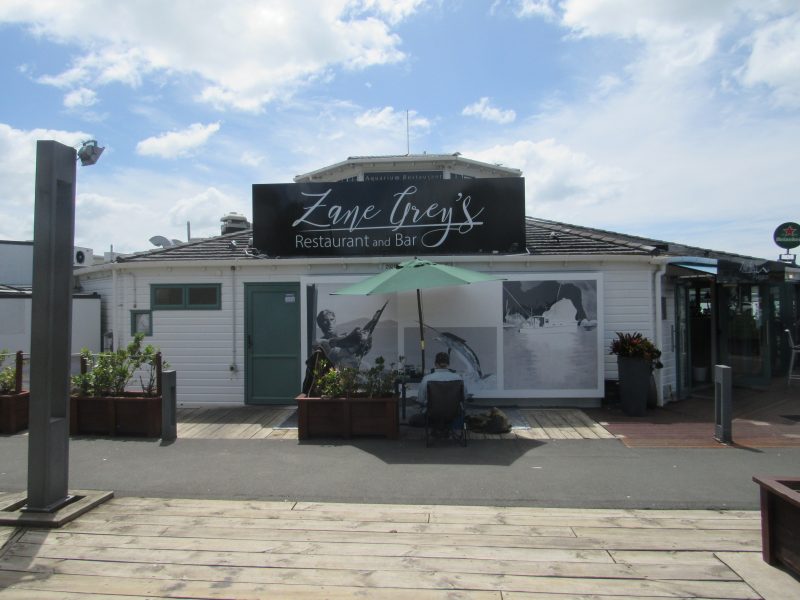
Zane Grey's Restaurant and Bar, named after the famous American author best known for his western tales.
But it’s true. Running off to exotic places makes us feel free. It’s our way of living a “wild life.” And this voyage is an exclamation mark that’s punctuating all our previous escapes.
Every morning I wake up, I pinch myself to see if I’m alive and not just dreaming that we’re onboard Queen Victoria. Really. Imagine, only a week ago, we were attending a welcome ceremony in Nuku’Alofa, the capital of Tonga, and yours truly was sipping kava from a coconut shell. Geez, I felt like Captain Cook.
And before that, we were knocking around Samoa snapping pics inside Robert Louis Stevenson’s home. Remember him? The Scottish author who penned such classics as
Treasure Island and
Kidnapped. Samoans called him “Tusitala,” teller of tales.
I’ll tell you, I could write volumes about the places we’ve visited so far, and all the stuff we’ve done. Hawaii, San Francisco, Cabo San Lucas, Puntarenas, Panama Canal. But with this ship banging the way it is — we just crashed through another wave — my fingers keep slipping across the keyboard of my laptop. No lie. I just tapped Backspace four times! Unintentionally! So, I’m signing off here, my friends. Australia, Bali, and Hong Kong are next on the itinerary — I’m sure there will be lots to tell.
Editor’s note: Henry Bender, of Ocean City, is a retired Ocean City High School English teacher turned full-time writer and global traveler. His seashore-themed book, “Stirring the Dust,” is a compilation of his articles and columns that appeared in newspapers and other publications. Accompanied by his wife, Karen, he is writing a first-hand account of his around-the-world cruise aboard the Queen Victoria for MediaWize/OCNJDaily.com. This is the third of five articles.
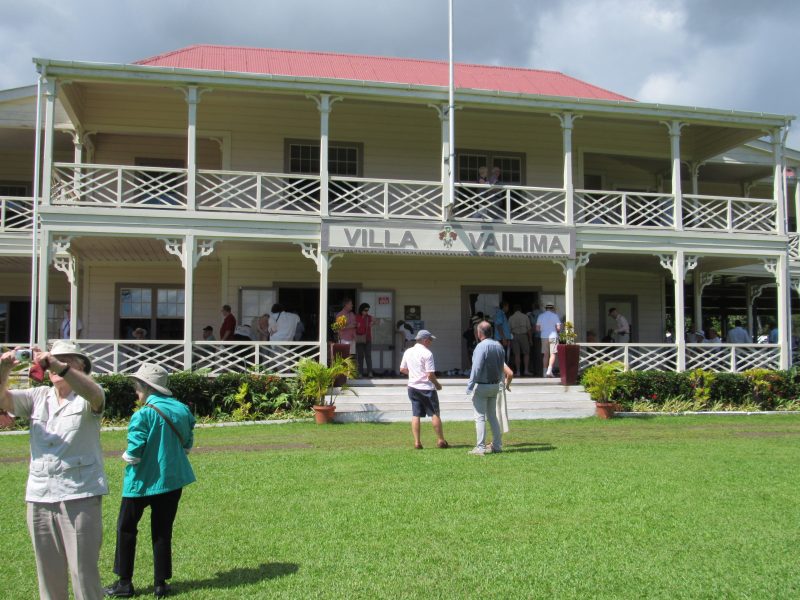
The former home of novelist Robert Louis Stevenson, the author of "Treasure Island."
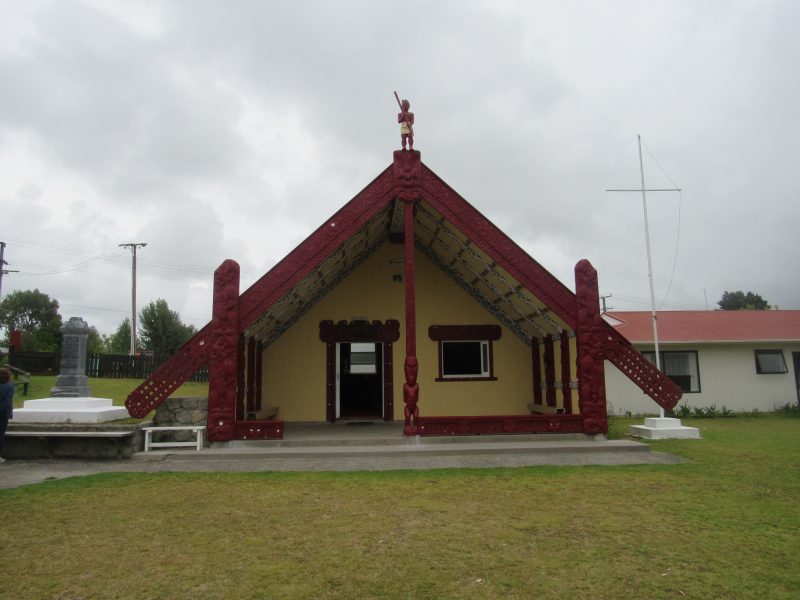
A "marae" gathering place resembles a church with tiki decorations.
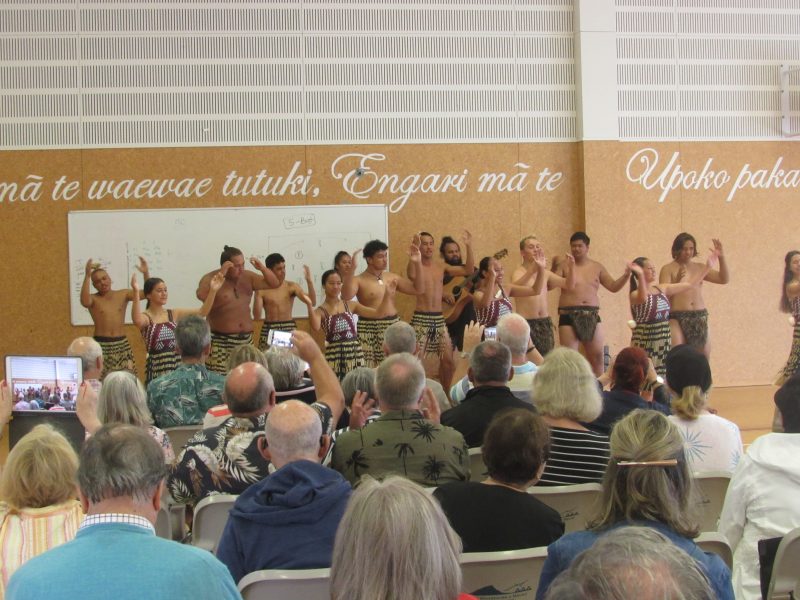
Maori children perform an ancestral dance.
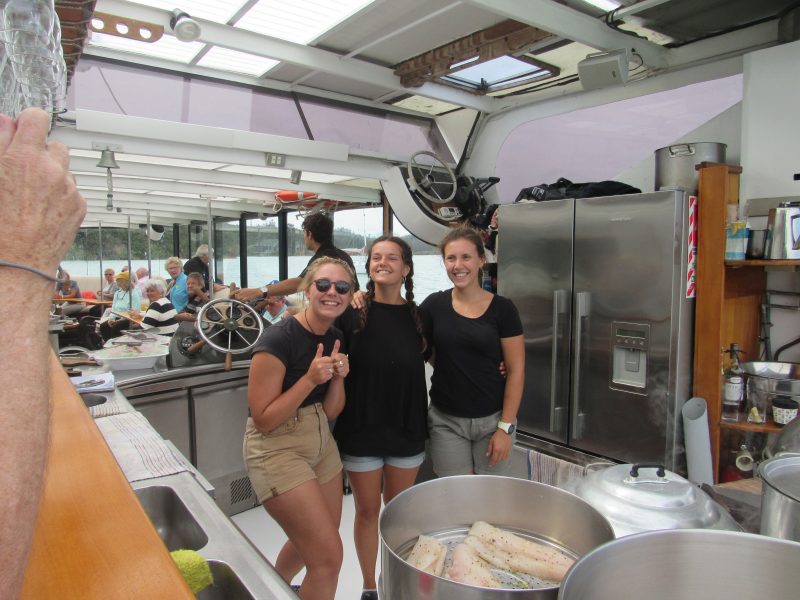
The river boat crew serves up lunch during a tour of the Bay of Islands.
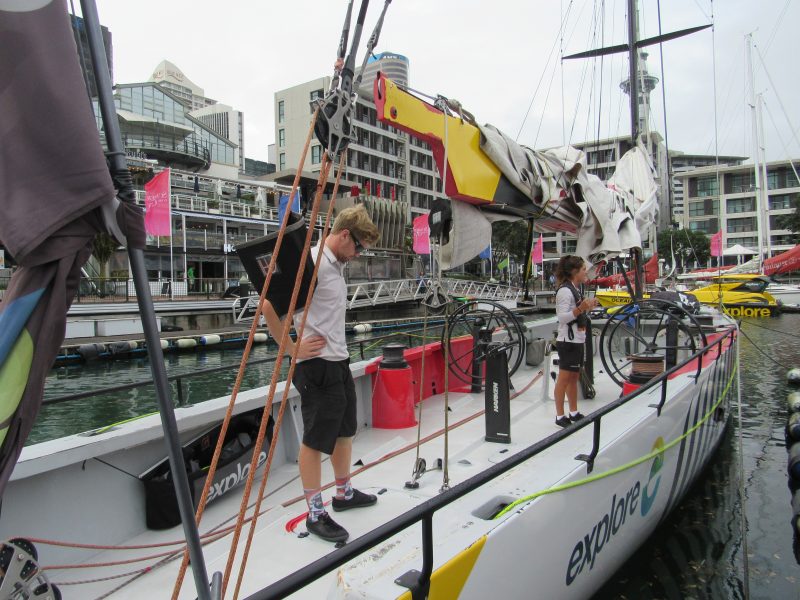
A ride on a sleek and fast America's Cup Yacht adds to the excitement.
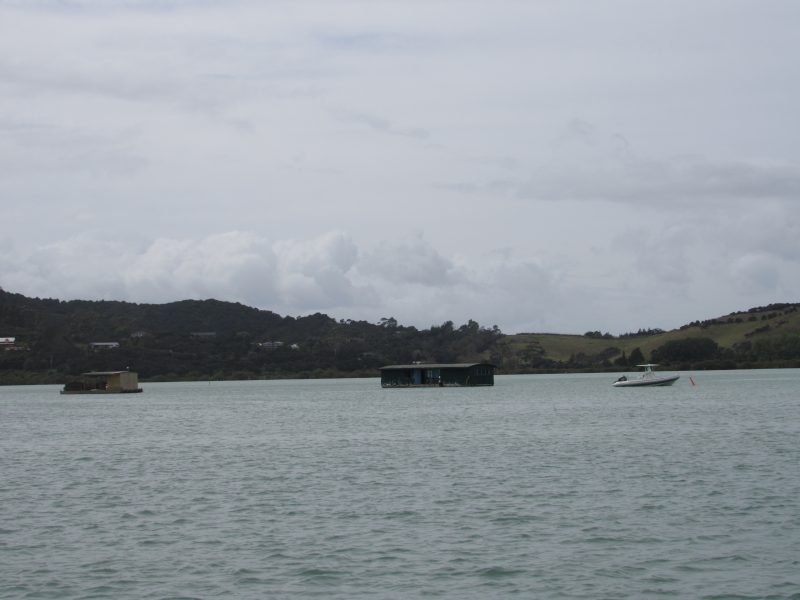
Cultured oysters are farm-raised in the Bay of Islands.
 By HENRY BENDER
Hey Gang,
Queen Victoria’s banging today — a lot! Waves are pushing six meters — that’s 21 feet. Some are probably higher. And the wind, well, she’s screaming like a banshee. Swimming pools are closed, so are the hot tubs, and several doors leading to the outside decks have been cordoned off. When I bumped into Captain Connery — he was coming from the bridge — I asked if he was concerned.
“Not at all,” he laughed. “We’re only experiencing some zephyrs with a little roughness.”
Some zephyrs? A little roughness? Barf bags are by every elevator! The Brits. You got to love them. They’re masters of understatement.
Right now, we’re barreling toward Australia. Another two days, we’ll be in Sydney. As I write this, we’re about 33 degrees south latitude/170 degrees east longitude, which places us — yep, you got it — Down Under in the southeast hemisphere, an area of the world where Karen and I have never been.
Only a few days ago, we were sailing around New Zealand — home to volcanoes, Kiwi fruit, and Maori culture. Oh, I almost forgot. And, the America’s Cup! That’s right. The Kiwis won the Auld Mug two years ago. So now, we Yanks will have to come to Auckland — New Zealand’s largest city — in 2021 to have a go at winning it back.
By HENRY BENDER
Hey Gang,
Queen Victoria’s banging today — a lot! Waves are pushing six meters — that’s 21 feet. Some are probably higher. And the wind, well, she’s screaming like a banshee. Swimming pools are closed, so are the hot tubs, and several doors leading to the outside decks have been cordoned off. When I bumped into Captain Connery — he was coming from the bridge — I asked if he was concerned.
“Not at all,” he laughed. “We’re only experiencing some zephyrs with a little roughness.”
Some zephyrs? A little roughness? Barf bags are by every elevator! The Brits. You got to love them. They’re masters of understatement.
Right now, we’re barreling toward Australia. Another two days, we’ll be in Sydney. As I write this, we’re about 33 degrees south latitude/170 degrees east longitude, which places us — yep, you got it — Down Under in the southeast hemisphere, an area of the world where Karen and I have never been.
Only a few days ago, we were sailing around New Zealand — home to volcanoes, Kiwi fruit, and Maori culture. Oh, I almost forgot. And, the America’s Cup! That’s right. The Kiwis won the Auld Mug two years ago. So now, we Yanks will have to come to Auckland — New Zealand’s largest city — in 2021 to have a go at winning it back.
 Author Henry Bender cranks up the main sail on the America's Cup Yacht, the NZL68
Located in the northern region of New Zealand’s North Island, Auckland spreads for 30 miles over an isthmus that connects two major harbors: Waitemata and Manukau. Maori call this land Tamaki Makaurau — a maiden desired by a hundred lovers. Green, lush and seductive, the volcanic hills surrounding the city are simply gorgeous.
Cup races are slated for the waters beyond Waitemata, where the island of Rangitoto, one of the most symmetrical volcanoes in the world (last eruption was 600 years ago) stands sentinel by the harbor’s entrance.
For fun, Karen and I signed onboard a genuine America’s Cup yacht, the NZL68, for a spin out there. The yacht was used by the Kiwis in Cup trials back in 2007. Long and narrow like a Maori war canoe, this skinny fiberglass shell, 78 feet in length, with a mast that shoots up 113 feet, was built with one intention only — to fly. And fly we did. We flew across Waitemata Harbor, we flew past the harbor bridge, and we flew past Rangitoto; in fact, we flew past every boat out there. And believe me, there were plenty. Auckland’s sobriquet is City of Sails. One in three households owns a boat!
I’ll tell you, it was a workout spinning those “grinders.” They’re the big winches that crank in the sails. My shoulders were aching. Best part though was manning the helm. For about ten minutes, yours truly pretended he was Dennis Connor. Ha!
Back at Viaduct Basin where we boarded the yacht — this man-made harbor is lined with some of the coolest cafes, restaurants, and bars you’d ever see — I said to Karen, “Let’s have a drink to celebrate our America’s Cup sail.”
At first, she hesitated, but after I whispered, “New Zealand’s known for its Sauvignon Blanc” there wasn’t much arm twisting. Sauvignon Blanc is one of her favorite wines. When Happy Hour rolled around four hours later, we were hanging with locals in The Crab Shack — our third watering-hole — over on Princess Wharf chowing down on greasies. That’s what the Kiwis call fish ‘n chips. Of course, my shoulders weren’t feeling any pain!
Author Henry Bender cranks up the main sail on the America's Cup Yacht, the NZL68
Located in the northern region of New Zealand’s North Island, Auckland spreads for 30 miles over an isthmus that connects two major harbors: Waitemata and Manukau. Maori call this land Tamaki Makaurau — a maiden desired by a hundred lovers. Green, lush and seductive, the volcanic hills surrounding the city are simply gorgeous.
Cup races are slated for the waters beyond Waitemata, where the island of Rangitoto, one of the most symmetrical volcanoes in the world (last eruption was 600 years ago) stands sentinel by the harbor’s entrance.
For fun, Karen and I signed onboard a genuine America’s Cup yacht, the NZL68, for a spin out there. The yacht was used by the Kiwis in Cup trials back in 2007. Long and narrow like a Maori war canoe, this skinny fiberglass shell, 78 feet in length, with a mast that shoots up 113 feet, was built with one intention only — to fly. And fly we did. We flew across Waitemata Harbor, we flew past the harbor bridge, and we flew past Rangitoto; in fact, we flew past every boat out there. And believe me, there were plenty. Auckland’s sobriquet is City of Sails. One in three households owns a boat!
I’ll tell you, it was a workout spinning those “grinders.” They’re the big winches that crank in the sails. My shoulders were aching. Best part though was manning the helm. For about ten minutes, yours truly pretended he was Dennis Connor. Ha!
Back at Viaduct Basin where we boarded the yacht — this man-made harbor is lined with some of the coolest cafes, restaurants, and bars you’d ever see — I said to Karen, “Let’s have a drink to celebrate our America’s Cup sail.”
At first, she hesitated, but after I whispered, “New Zealand’s known for its Sauvignon Blanc” there wasn’t much arm twisting. Sauvignon Blanc is one of her favorite wines. When Happy Hour rolled around four hours later, we were hanging with locals in The Crab Shack — our third watering-hole — over on Princess Wharf chowing down on greasies. That’s what the Kiwis call fish ‘n chips. Of course, my shoulders weren’t feeling any pain!
 The author's wife, Karen Bender, is joined by a Tongan warrior.
Anyhow, as I mentioned previously, Maori culture thrives in New Zealand or Aotearoa — that’s the Maori name for these islands. The earliest tribes arrived in the late 12th century. What boggles my mind is how they made their way from Polynesia. Imagine, sliding down 20-foot waves in open sailing canoes. They must’ve been crazy!
Before Auckland, Queen Victoria called on Tauranga, about 125 miles to the south. Meaning sheltered anchorage, Tauranga is the largest city in the Bay of Plenty (Captain Cook’s appellation; given when he arrived in 1769) where kiwi fruit and avocadoes are the major exports.
A tour we went on stopped at a Maori school. For about an hour some Maori teeny-boppers dressed in ancient garb showcased their ancestors’ ways along with some older teens. Girls sang, they danced, they waved their arms as bare-chested boys, stuck out their tongues, bulged their eyes, and waved wooden spears.
Other than this focus on culture and heritage, the school’s curriculum is really no different than that of an American or European school. English, math, science — it’s all being taught. We sat inside a gymnasium on fold-out chairs for the entertainment. Outside, newly paved tennis courts baked in the sun.
Afterwards we were whisked off to a marae, a Maori tribe gathering place — a building that resembles a church with tiki decorations — for a rather formal Maori ceremony.
The author's wife, Karen Bender, is joined by a Tongan warrior.
Anyhow, as I mentioned previously, Maori culture thrives in New Zealand or Aotearoa — that’s the Maori name for these islands. The earliest tribes arrived in the late 12th century. What boggles my mind is how they made their way from Polynesia. Imagine, sliding down 20-foot waves in open sailing canoes. They must’ve been crazy!
Before Auckland, Queen Victoria called on Tauranga, about 125 miles to the south. Meaning sheltered anchorage, Tauranga is the largest city in the Bay of Plenty (Captain Cook’s appellation; given when he arrived in 1769) where kiwi fruit and avocadoes are the major exports.
A tour we went on stopped at a Maori school. For about an hour some Maori teeny-boppers dressed in ancient garb showcased their ancestors’ ways along with some older teens. Girls sang, they danced, they waved their arms as bare-chested boys, stuck out their tongues, bulged their eyes, and waved wooden spears.
Other than this focus on culture and heritage, the school’s curriculum is really no different than that of an American or European school. English, math, science — it’s all being taught. We sat inside a gymnasium on fold-out chairs for the entertainment. Outside, newly paved tennis courts baked in the sun.
Afterwards we were whisked off to a marae, a Maori tribe gathering place — a building that resembles a church with tiki decorations — for a rather formal Maori ceremony.
 A woman and a local warrior greet visitors at a "marae," a Maori gathering place.
When we climbed from our bus, we all assembled at the marae’s gateway. Women were instructed to stand in the front. A local warrior then greeted us. His job was to make sure we weren’t going to kill anyone. Once peaceful intentions were realized, a Maori woman from the marae started chanting, calling out to our ancestors to join hers.
After her chant, our women and men switched positions — men now up front; women in the rear. Then everyone removed their shoes, and we entered the marae where we sat on long wooden benches. Since men led the way in, we sat upfront facing the tribe’s chief and other VIPs.
Once seated, two speeches followed, welcoming us — one in Maori, the other in English. Then we sang a waiata or song. When it finally came time to leave, we queued up and touched noses and foreheads with tribe members. Called a hongi, this is the most sacred part of the ceremony, because the gesture represents sharing life, peace, and knowledge.
Just in case you’re wondering, no one was sporting grass skirts or running around in their birthday suit. The Maoris dress like typical Europeans or Americans. But hey, they are inked up, and their tattoos tell stories — stories personal to them.
A woman and a local warrior greet visitors at a "marae," a Maori gathering place.
When we climbed from our bus, we all assembled at the marae’s gateway. Women were instructed to stand in the front. A local warrior then greeted us. His job was to make sure we weren’t going to kill anyone. Once peaceful intentions were realized, a Maori woman from the marae started chanting, calling out to our ancestors to join hers.
After her chant, our women and men switched positions — men now up front; women in the rear. Then everyone removed their shoes, and we entered the marae where we sat on long wooden benches. Since men led the way in, we sat upfront facing the tribe’s chief and other VIPs.
Once seated, two speeches followed, welcoming us — one in Maori, the other in English. Then we sang a waiata or song. When it finally came time to leave, we queued up and touched noses and foreheads with tribe members. Called a hongi, this is the most sacred part of the ceremony, because the gesture represents sharing life, peace, and knowledge.
Just in case you’re wondering, no one was sporting grass skirts or running around in their birthday suit. The Maoris dress like typical Europeans or Americans. But hey, they are inked up, and their tattoos tell stories — stories personal to them.
 The picturesque Bay of Islands is another port-of-call on the tour.
The Bay of Islands (another Captain Cook appellation) 150 miles north of Auckland was our final port-of-call. Rolling landscapes. Silvery beaches. Rich forest land. This archipelago, dubbed New Zealand’s finest maritime park, consists of 144 islands.
Here, Queen Victoria dropped anchor in the main bay, only a stone’s throw from the small town of Waitangi. Waitangi means weeping waters. A slow-moving river of the same name runs past the town. Once our anchor was set, several lifeboats were lowered as tenders, and passengers were shuttled to Waitangi’s small wharf.
There, Karen and I joined thirty others aboard a flat bottom river boat for a leisurely cruise to Russell, one of New Zealand’s oldest towns. The journey only took about thirty minutes. Quiet and sleepy, you’d never suspect this little waterfront village with its quaint old homesteads, historic churches, and wooden cottages was once over-run with drunk sailors and prositutes. But it was. Founded as a whaling port early in the 19th century, Russell was known as the “hell-hole” of the southwest Pacific. It was also New Zealand’s capital from 1840 to 1844.
In 1866 angry Maoris tried burning this little den of iniquity to the ground. Why? Because they were upset about the Waitangi Treaty. As the story goes, Maori chiefs in 1840 mistakenly signed away their sovereignty, handing it all over to Great Britain. When they realized they’d screwed up, it was too late, the ink on the parchment was already dry. As you’d might expect the Maoris claimed they’d been duped. Whether they were, no one’s certain. But the treaty’s still in effect, and still stirs up protests from time to time.
Fortunately, though, for the sailors and harlots, Russell’s prized bordello — New Zealand’s first house of ill-repute — survived the inferno. Today, refurbished and remodeled, this tiny white bungalow, which sits on the outskirts of town, operates as an expensive rental property. Yep, this tiny tribute to Russell’s bawdy past, now rakes in bucks weekly rather than hourly. We passed it after leaving Russell on our way to the oyster farms.
The picturesque Bay of Islands is another port-of-call on the tour.
The Bay of Islands (another Captain Cook appellation) 150 miles north of Auckland was our final port-of-call. Rolling landscapes. Silvery beaches. Rich forest land. This archipelago, dubbed New Zealand’s finest maritime park, consists of 144 islands.
Here, Queen Victoria dropped anchor in the main bay, only a stone’s throw from the small town of Waitangi. Waitangi means weeping waters. A slow-moving river of the same name runs past the town. Once our anchor was set, several lifeboats were lowered as tenders, and passengers were shuttled to Waitangi’s small wharf.
There, Karen and I joined thirty others aboard a flat bottom river boat for a leisurely cruise to Russell, one of New Zealand’s oldest towns. The journey only took about thirty minutes. Quiet and sleepy, you’d never suspect this little waterfront village with its quaint old homesteads, historic churches, and wooden cottages was once over-run with drunk sailors and prositutes. But it was. Founded as a whaling port early in the 19th century, Russell was known as the “hell-hole” of the southwest Pacific. It was also New Zealand’s capital from 1840 to 1844.
In 1866 angry Maoris tried burning this little den of iniquity to the ground. Why? Because they were upset about the Waitangi Treaty. As the story goes, Maori chiefs in 1840 mistakenly signed away their sovereignty, handing it all over to Great Britain. When they realized they’d screwed up, it was too late, the ink on the parchment was already dry. As you’d might expect the Maoris claimed they’d been duped. Whether they were, no one’s certain. But the treaty’s still in effect, and still stirs up protests from time to time.
Fortunately, though, for the sailors and harlots, Russell’s prized bordello — New Zealand’s first house of ill-repute — survived the inferno. Today, refurbished and remodeled, this tiny white bungalow, which sits on the outskirts of town, operates as an expensive rental property. Yep, this tiny tribute to Russell’s bawdy past, now rakes in bucks weekly rather than hourly. We passed it after leaving Russell on our way to the oyster farms.
 Russell, one of New Zealand's oldest towns, features an old former bordello that now functions as a rental property.
The Kororareka Oyster farms aren’t much of a tourist attraction There’s nothing to see but water. So, we moseyed around enjoying views of the picturesque countryside. Around noon, the captain dropped the hook and his crew served up lunch. Venison. Lamb. Gurnard, which is a local fish. Boiled white potatoes. Tossed salad. And of course, Sauvignon Blanc. And too, New Zealand’s go to beers — Lion Red and Steinlager. No longer meat eaters, Karen and I gobbled up fish — simply delicious! And yes, we threw down a couple of glasses of Sauvignon Banc. No way were we resisting that!
After our cruise, instead of returning to Queen Victoria, Karen and I hopped the shuttle bus (Cunard does an excellent job of arranging free shuttles in our ports-of-call) into Paihia, another small waterfront town that’s just down the road from Waitangi. Thank goodness we did because we discovered the Zane Grey Bar & Restaurant. What an awesome place! Right on the water.
I’ll tell you, learning that Zane Grey ventured here blew my mind. I only thought he fished the Florida Keys and wrote westerns. But he was here all right, in 1926, sportfishing for marlin and shark. There were some faded black and white photos of him hanging on the wall. Today, Paihia hosts a number of big game fishing tournaments. And this bar’s a major sponsor.
One take-away I swiped from this watering-hole is a Zane Grey quote: “I need this wild life, this freedom.” It’s painted on the wall by the bar’s entrance.
As soon as I saw it, I nudged Karen and pointed it out to her. “Babe, that’s how we are,” I said.
She giggled, which meant she agreed.
Russell, one of New Zealand's oldest towns, features an old former bordello that now functions as a rental property.
The Kororareka Oyster farms aren’t much of a tourist attraction There’s nothing to see but water. So, we moseyed around enjoying views of the picturesque countryside. Around noon, the captain dropped the hook and his crew served up lunch. Venison. Lamb. Gurnard, which is a local fish. Boiled white potatoes. Tossed salad. And of course, Sauvignon Blanc. And too, New Zealand’s go to beers — Lion Red and Steinlager. No longer meat eaters, Karen and I gobbled up fish — simply delicious! And yes, we threw down a couple of glasses of Sauvignon Banc. No way were we resisting that!
After our cruise, instead of returning to Queen Victoria, Karen and I hopped the shuttle bus (Cunard does an excellent job of arranging free shuttles in our ports-of-call) into Paihia, another small waterfront town that’s just down the road from Waitangi. Thank goodness we did because we discovered the Zane Grey Bar & Restaurant. What an awesome place! Right on the water.
I’ll tell you, learning that Zane Grey ventured here blew my mind. I only thought he fished the Florida Keys and wrote westerns. But he was here all right, in 1926, sportfishing for marlin and shark. There were some faded black and white photos of him hanging on the wall. Today, Paihia hosts a number of big game fishing tournaments. And this bar’s a major sponsor.
One take-away I swiped from this watering-hole is a Zane Grey quote: “I need this wild life, this freedom.” It’s painted on the wall by the bar’s entrance.
As soon as I saw it, I nudged Karen and pointed it out to her. “Babe, that’s how we are,” I said.
She giggled, which meant she agreed.
 Zane Grey's Restaurant and Bar, named after the famous American author best known for his western tales.
But it’s true. Running off to exotic places makes us feel free. It’s our way of living a “wild life.” And this voyage is an exclamation mark that’s punctuating all our previous escapes.
Every morning I wake up, I pinch myself to see if I’m alive and not just dreaming that we’re onboard Queen Victoria. Really. Imagine, only a week ago, we were attending a welcome ceremony in Nuku’Alofa, the capital of Tonga, and yours truly was sipping kava from a coconut shell. Geez, I felt like Captain Cook.
And before that, we were knocking around Samoa snapping pics inside Robert Louis Stevenson’s home. Remember him? The Scottish author who penned such classics as Treasure Island and Kidnapped. Samoans called him “Tusitala,” teller of tales.
I’ll tell you, I could write volumes about the places we’ve visited so far, and all the stuff we’ve done. Hawaii, San Francisco, Cabo San Lucas, Puntarenas, Panama Canal. But with this ship banging the way it is — we just crashed through another wave — my fingers keep slipping across the keyboard of my laptop. No lie. I just tapped Backspace four times! Unintentionally! So, I’m signing off here, my friends. Australia, Bali, and Hong Kong are next on the itinerary — I’m sure there will be lots to tell.
Editor’s note: Henry Bender, of Ocean City, is a retired Ocean City High School English teacher turned full-time writer and global traveler. His seashore-themed book, “Stirring the Dust,” is a compilation of his articles and columns that appeared in newspapers and other publications. Accompanied by his wife, Karen, he is writing a first-hand account of his around-the-world cruise aboard the Queen Victoria for MediaWize/OCNJDaily.com. This is the third of five articles.
Zane Grey's Restaurant and Bar, named after the famous American author best known for his western tales.
But it’s true. Running off to exotic places makes us feel free. It’s our way of living a “wild life.” And this voyage is an exclamation mark that’s punctuating all our previous escapes.
Every morning I wake up, I pinch myself to see if I’m alive and not just dreaming that we’re onboard Queen Victoria. Really. Imagine, only a week ago, we were attending a welcome ceremony in Nuku’Alofa, the capital of Tonga, and yours truly was sipping kava from a coconut shell. Geez, I felt like Captain Cook.
And before that, we were knocking around Samoa snapping pics inside Robert Louis Stevenson’s home. Remember him? The Scottish author who penned such classics as Treasure Island and Kidnapped. Samoans called him “Tusitala,” teller of tales.
I’ll tell you, I could write volumes about the places we’ve visited so far, and all the stuff we’ve done. Hawaii, San Francisco, Cabo San Lucas, Puntarenas, Panama Canal. But with this ship banging the way it is — we just crashed through another wave — my fingers keep slipping across the keyboard of my laptop. No lie. I just tapped Backspace four times! Unintentionally! So, I’m signing off here, my friends. Australia, Bali, and Hong Kong are next on the itinerary — I’m sure there will be lots to tell.
Editor’s note: Henry Bender, of Ocean City, is a retired Ocean City High School English teacher turned full-time writer and global traveler. His seashore-themed book, “Stirring the Dust,” is a compilation of his articles and columns that appeared in newspapers and other publications. Accompanied by his wife, Karen, he is writing a first-hand account of his around-the-world cruise aboard the Queen Victoria for MediaWize/OCNJDaily.com. This is the third of five articles.
 The former home of novelist Robert Louis Stevenson, the author of "Treasure Island."
The former home of novelist Robert Louis Stevenson, the author of "Treasure Island."
 A "marae" gathering place resembles a church with tiki decorations.
A "marae" gathering place resembles a church with tiki decorations.
 Maori children perform an ancestral dance.
Maori children perform an ancestral dance.
 The river boat crew serves up lunch during a tour of the Bay of Islands.
The river boat crew serves up lunch during a tour of the Bay of Islands.
 A ride on a sleek and fast America's Cup Yacht adds to the excitement.
A ride on a sleek and fast America's Cup Yacht adds to the excitement.
 Cultured oysters are farm-raised in the Bay of Islands.
Cultured oysters are farm-raised in the Bay of Islands.